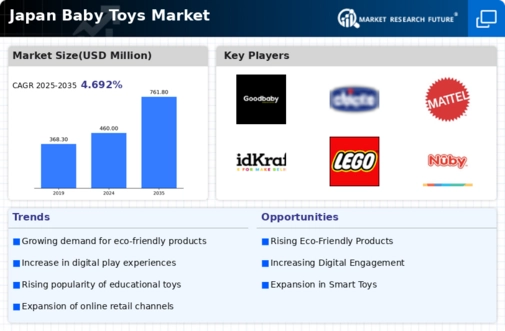The Japan Baby Toys Market is characterized by a competitive landscape that is driven by the increasing demand for innovative, safe, and educational toys for infants and young children. The market benefits from a combination of local and international brands vying for consumer attention, each striving to differentiate their offerings through design, functionality, and sustainability. The Japanese culture values high quality and safety in products for children, which influences manufacturers to prioritize these attributes in their toys.
As a result, the industry has witnessed robust growth, with companies continuously adapting to shifting consumer preferences and technological advancements while navigating the complexities of regulatory compliance concerning toy safety.Goodbaby International has established a significant presence within the Japan Baby Toys Market. Known for its commitment to safety and quality, the company leverages advanced technology and innovative designs to cater to the diverse needs of Japanese consumers. Goodbaby International focuses on creating educational and developmental toys that are not only entertaining but also supportive of early childhood development milestones.
The company's strengths lie in its efficient supply chain, strong brand reputation among parents, and a wide range of product offerings that include strollers, tricycles, and various interactive toys. This strategic positioning allows Goodbaby International to capture a sizable market share while expanding its influence through collaborations and partnerships with local retailers.Chicco has also proven to be a formidable player in the Japan Baby Toys Market, focusing on creating products that encompass health, nutrition, and development for babies.
The company's portfolio includes a variety of toys, feeding products, and baby care items, all designed with the aim of enhancing the parenting experience. Chicco stands out due to its commitment to research and development, ensuring that its products align with the latest safety standards and developmental insights. By leveraging strong marketing strategies and establishing a robust distribution network, Chicco has solidified its market presence in Japan. The company has undertaken various mergers and acquisitions to enhance its product offerings and expand its reach, fostering growth while adapting to the unique cultural aspects of the Japanese consumer landscape.
Through its extensive range and reputation for excellence, Chicco effectively addresses the demands of modern parents seeking quality baby care products.

























Leave a Comment